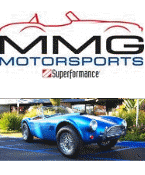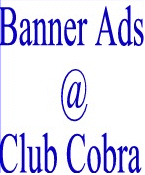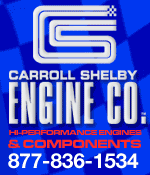 
 Main Menu
Main Menu
|
 Nevada Classics
Nevada Classics
|
 Advertise at CC
Advertise at CC
|
 November 2025
November 2025
|
| S |
M |
T |
W |
T |
F |
S |
| |
|
|
|
|
|
1 |
| 2 |
3 |
4 |
5 |
6 |
7 |
8 |
| 9 |
10 |
11 |
12 |
13 |
14 |
15 |
| 16 |
17 |
18 |
19 |
20 |
21 |
22 |
| 23 |
24 |
25 |
26 |
27 |
28 |
29 |
| 30 |
|
|
|
|
|
|
|
 CC Advertisers
CC Advertisers
|
|

04-29-2004, 08:30 PM
|
 |
CC Member

|
|
|
Join Date: Jan 2002
Location: Northern California,
CA
Cobra Make, Engine: -Sold- Contemporary 427S/C # CCX-3152 1966 427 Med Rise Side Oiler, 8v 3.54:1 Salisbury IRS, Koni's.. (Now I'm riding Harleys)
Posts: 2,567
|
|

 Not Ranked
Not Ranked
 Driveshaft Question
Driveshaft Question
Hi Guys,
I am having a situation with my driveline. After removing my 428 and installing a 427 SO. I got a driveline vibration.
Under the car looking rearward the tranny seems lined up pretty well with the frame rails. As you look further rearward the Salisbury (in a Contemporary) sits slightly off-set to the left, It appears to be designed this way with the main part of the pumpkin centered, but the pinion shaft about a half inch to the passanger side. It seems wierd but It is, I assume normal, as the car has never been damaged, the rear wheels line up, tires are equal distance from the fenders, etc.
In any case there is now (since putting in the side oiler) a pronounced jog in the driveshaft left to right between the tail shaft and the pinion flange. I had a shop look at it and he was baffled (not a cobra or component car shop).
My question is I think for Contemporary owners mostly, but anyone really, Does a left to right offset create a a vibration like an up / down pinion offset does?
It seems like a no brainer. Maybe my shop guy was apprehensive about working on a "kit car" without a factory spec. to work from or maybe he was still wigged out about going 0-100 in under 10 seconds.
In any case he noted a small difference in the up down pinion angle and suggested I start there.
Thanks in advance,
__________________
michael
A man that is young in years, may be old in hours, if he have lost no time. But that happeneth rarely. Generally, youth is like the first cogitations, not so wise as the second. For there is a youth in thoughts, as well as in ages... Sir Francis Bacon (1561-1626)
|
-
Advertising


04-30-2004, 10:05 AM
|
|
CC Member

|
|
|
Join Date: Mar 1999
Location: TACOMA,
WA
Cobra Make, Engine: Everett Morrision FE 427 so 2-4s
Posts: 2,025
|
|

 Not Ranked
Not Ranked
Are you sure that the joints are seated into the coresponding sockets? I find that the vehicles that I work on frequently have the bolts tight but the parts aren't seated properly.If uncorrected they end up loosening the bolts and breaking and throwing the drive line.Either end ,boy does that make a mess.I can't emagine driving when that happens.I'm talking about Millitary M113 personel vehicle. Mostly the vehicles were just thrown together and the failure happenes while being towed.It ponds and caves the 3/8" alluminum wall between the drivers feet and the driveline to death. Welders spend a lot of time patching after I've removed everything in that area.
__________________
Mike H
|

04-30-2004, 03:39 PM
|
 |
CC Member

|
|
|
Join Date: Jan 2002
Location: Northern California,
CA
Cobra Make, Engine: -Sold- Contemporary 427S/C # CCX-3152 1966 427 Med Rise Side Oiler, 8v 3.54:1 Salisbury IRS, Koni's.. (Now I'm riding Harleys)
Posts: 2,567
|
|

 Not Ranked
Not Ranked
They were unchanged during the engine swap. and have been in the same place since 1988 (20k miles). Maybe it's just time to change them. I spoke to a driveline specialist in Sacramento, he seemed to think it was a balance issue. I will be getting the driveshaft and flanges rebalanced and the u-joints replaced tomarrow.
At that time I will get the measurements of the output shaft and the pinion between the frame rails. In my search for answers I have noticed several driveline configurations in which the pinion flange is offset to the tailshaft as it is (now, and maybe prior to the engine swap... I wish I'd paid more attention to their position before)
We'll see.
__________________
michael
A man that is young in years, may be old in hours, if he have lost no time. But that happeneth rarely. Generally, youth is like the first cogitations, not so wise as the second. For there is a youth in thoughts, as well as in ages... Sir Francis Bacon (1561-1626)
|

04-30-2004, 08:31 PM
|
|
CC Member

|
|
|
Join Date: Mar 1999
Location: TACOMA,
WA
Cobra Make, Engine: Everett Morrision FE 427 so 2-4s
Posts: 2,025
|
|

 Not Ranked
Not Ranked
Could you have thrown off a formally tack welded weight?Could something be bent?anything off center ?
__________________
Mike H
|

04-30-2004, 09:35 PM
|
 |
CC Member

|
|
|
Join Date: Jan 2002
Location: Northern California,
CA
Cobra Make, Engine: -Sold- Contemporary 427S/C # CCX-3152 1966 427 Med Rise Side Oiler, 8v 3.54:1 Salisbury IRS, Koni's.. (Now I'm riding Harleys)
Posts: 2,567
|
|

 Not Ranked
Not Ranked
 interesting... the offest is intentional
interesting... the offest is intentional
No, although sometimes just because nothing was changed doesn't mean it was alright before you started... I took some measurements. I found the tailshaft of my toploader to be within 3/16" of the 18 1/4" distance between the frame rails of the Contemporary.
The interesting thing is, the pinion flange is indeed offset. it is 8 3/8" off the passenger side frame rail. That gives a total offset of 1 1/2" off centerline. I guess this is normal. Who knew. I never paid much attention. I took the driveshaft out and it doesn't look like it's thrown a weight but it seems like an amature put it together. The face of the yoke isn't straight. It looks like it was hacked off with a hand saw. One U joint seems to have a point at wich it sticks as I turn it by hand. In either case It seems suspect and needs attention.
I suspect somehow changing the orientation of the engine with the transmission, despite it being correct has changed the dynamics or the way the driveline "feels" and the harmonic characterists it has despite not actually being worked on, or changed during the engine swap.
Thanks for the input and for everyone that looked at the thread, problems like this are frustrating and take patients to solve. I will update this thread as soon as I get my driveshaft back from Dirveline Speciality Service in Sacramento, CA early next week. They promise a 24 hour turn around and are open on Saturday.
I would like to say the guy who was reluctant to alter my transmission orientation was probably right, at least he was from a distance to centerline perspective. Everything seems like it is where it should be. So thanks Gear One in Vacaville, Ca and Jim in particular. He took the time to put my car on his rack and spent a 1/2 hour talking me out of changing the position of my toploader. NO Charge.
I'll let you know how it works out,
__________________
michael
A man that is young in years, may be old in hours, if he have lost no time. But that happeneth rarely. Generally, youth is like the first cogitations, not so wise as the second. For there is a youth in thoughts, as well as in ages... Sir Francis Bacon (1561-1626)
|

04-30-2004, 11:03 PM
|
|
CC Member

|
|
|
Join Date: Jan 1999
Location: Bakersfield,
CA
Cobra Make, Engine: HI-TECH 289 FIA
Posts: 363
|
|

 Not Ranked
Not Ranked
Iwas told that the drive line is offset 5/8" to the pass side. Thats the way mine is set. As long as the drive line axis and the pinion axis are parallel and the tail shaft and pinion faces are parallel there should not be a phase problem. You didn't use the 428 flywheel on the 427 did you?
__________________
fiaroadster
|

05-02-2004, 12:30 PM
|
 |
CC Member

|
|
|
Join Date: Jan 2002
Location: Northern California,
CA
Cobra Make, Engine: -Sold- Contemporary 427S/C # CCX-3152 1966 427 Med Rise Side Oiler, 8v 3.54:1 Salisbury IRS, Koni's.. (Now I'm riding Harleys)
Posts: 2,567
|
|

 Not Ranked
Not Ranked
 Driveline Specialties
Driveline Specialties
Thanks Rick,
I got my driveshaft back in 5 hours from Driveline Specialties in Sacramento. Amazing, they squared up the yoke, replaced the driveshaft end that the yoke mates with, replaced the u-joints painted it and balanced it for $104.
The bad news is I still have the vibration. I suspect it is all in the pinion and tailshaft angles. 3 degrees is said to be the maximum for such a short shaft, including any for offset. I'm probably closer to 5 with the elevation (up/down) and offset (left right).
I have My tailshaft is pretty much dead center between the frame rails My pinion axis is more like 1.5" to the passenger side, as measured between the frame rails it's 8 3/8" off the passengers side tube and 9 7/8" off the drivers. The Contemporary differential is intergral with the frame at that point and has no real provision for adjustment there.
I may need to bring the tranny over to get a net offset of closer to 5/8" total. I also noticed the headers seem lower in front than when the 428 was in place I think raising the front of the engine, while lowering the back of the transmission is next to bring the 5 degrees closer to 2 or 3 total...
No... I didn't use the 428 flywheel 
__________________
michael
A man that is young in years, may be old in hours, if he have lost no time. But that happeneth rarely. Generally, youth is like the first cogitations, not so wise as the second. For there is a youth in thoughts, as well as in ages... Sir Francis Bacon (1561-1626)
|

05-02-2004, 04:45 PM
|
 |
CC Member

|
|
|
Join Date: Jan 2002
Location: Northern California,
CA
Cobra Make, Engine: -Sold- Contemporary 427S/C # CCX-3152 1966 427 Med Rise Side Oiler, 8v 3.54:1 Salisbury IRS, Koni's.. (Now I'm riding Harleys)
Posts: 2,567
|
|

 Not Ranked
Not Ranked

I lifted this off the internet, It seems to confirm what the guys at Gear One thought. It looks like a lateral offset is no big deal. The big deal comes when either the tailshaft or the pinion flange, or both are at different angles, or the combination of angles exceeds the 3% number. The number will change with driveshaft speed and length. Here's the article for future reference.
What every shop must know about drivelines...
For those who depend on drivelines, there is no such thing as good vibrations. When drivelines shake, components fail, Tom Koedam said at a workshop on driveshafts and universal joints held at the NTEA convention in St Louis.
And when drivelines experience vibrations, the common cause is a mechanic who did not adhere to basic principles.
"I am convinced that many of the problems we experience-failures of pumps, gears breaking in PTOs, and PTO mounting bolts coming loose-are caused by improper driveshaft installations," said Koedam, driveshaft brand development manager for the Drivetrain Services Division of Dana Corporation. "Very rarely does anything other than installation errors produce vibrations that are strong enough to cause hydraulic pumps and power take-offs to fail."
Koedam listed three types of vibrations that troubleshooters should know-transverse, torsional, and critical speed vibrations.
Transverse vibrations occur once per revolution. They usually are caused by an imbalance in the driveshaft or an imbalance between the driveshaft and its connecting members. The solution is simple-have the driveshaft balanced.
Torsional vibrations occur twice every time the driveshaft rotates. These result from excessive angles in the u-joints. They also can be caused by driveshafts that have been reassembled out of phase. A phased driveshaft generally is one in which the yokes are in line. However, it is not uncommon for chassis manufacturers to order driveshafts with special phasing.
"Torsional vibrations are one of the biggest installation problems you will encounter," Koedam said.
Koedam suggested that shops mark driveline components before disassembling them. Mark them in a way that makes it clear that the driveline is being reassembled the same way the manufacturer built it.
One good way to identify specially phased drivelines is to look at the weld seam on the tubing. If the weld seam is straight but the yoke is turned, the driveline probably has been built out of phase.
U-Joint Operating Angles U-joint operating angles-the angle produced between the driving member (such as the transmission or a power take-off) and a driveshaft-are major factors in driveline vibration problems.
Both ends of a driveline have an operating angle-formed at one end between the driving member and one end of the driveshaft and on the other end between the driveshaft and the component being driven. U-joints can operate either at simple angles (the direction changes only in one plane) or at a compound angle (the direction changes in two planes).
Simple driveline operating angles can be found with a protractor. Measure the slopes of both ends of the driveline and subtract the difference.
Added Complexity With compound angles, the parts components of the driveline do not line up in the top view or in the side view. To determine the size of a compound angle, it must be measured in the side view and the top view. The angle in the top view can be calculated by measuring the length of the driveshaft and the amount of the lateral offset. Looking up those dimensions on a chart available from Spicer will provide the angle-without the use of trigonometry. The true u-joint operating angle is a combination of the top- and side-view angles. It is the square root of the result one receives when adding the square of the top-view angle and the square of the side-view angle.
"Even though we calculate the angles for the top and side views, this final calculated compound angle is the only one you need to control in your installation," Koedam said. "But you have to control it on both ends of the driveshaft."
Spicer has developed guides for u-joint operating angles. * Keep the true angles less than 3 degrees if possible. Three-degree operating angles do not produce vibrations severe enough to cause damage, Koedam said. * Keep the angles on each end equal within one degree. When the angles at both ends are equal, they cancel out the torsional vibration that is generated at the drive end of the driveshaft. * Never assemble a driveline so that both ends are exactly the same. The roller bearings in u-joints must have a half-degree difference in order to rotate. Why U-Joints Vibrate
Unlike the constant velocity joints found on many automobiles, u-joints vibrate twice per revolution when placed at an angle. The nonuniform velocity of the u-joint and the driveshaft connected to it is what causes the vibration.
Koedam has measured the variation in velocity as driveshafts rotate. When a u-joint is placed at a 30-degree angle and rotated at a constant speed of 1000 rpm, the driveshaft actually speeds up to 1300 rpm and slows down to 700 rpm. If the other end of the driveshaft has a similar 30-degree angle, it slows down to 700 rpm at the same time that the other end speeds up to 1300 rpm.
"If the angles of the front and rear u-joints are within a degree of one another, the speeds of the input and output yokes are exact opposites," Koedam said. "It cancels the torsional vibrations and also delivers a uniform speed to the output yoke-just like the front yoke. If these angles aren't equal, the torsionals at the front of the driveline are transferred to all of the components. These torsional vibrations can cause significant problems in vehicles."
Having the driveline in phase is especially important if the driveline must operate with high u-joint operating angles. The higher the operating angle, the more vibration an out-of-phase driveline produces, Koedam said. How It Happens Koedam said that a problem occurs when mechanics remove the driveshaft by pulling it out of the slip yoke. By being off just one tooth, the driveline can vibrate. "We only allow the driveline to be out of phase by one degree," Koedam said. "If you are one tooth off, the driveline is out of phase by 221/2 degrees."
Torsional vibrations cause a wide range of failures, including transmission synchronizers.
Critical speed vibrations are produced when the driveshaft turns excessively fast.
To decrease the chances of having a driveshaft vibration problem: * Always have driveshafts balanced. * Have driveshafts assembled in phase. Mark existing shafts so that they can be reassembled with the original phasing. * Know the true operating angles of the U-joint and never assemble a driveline with excessive operating angles.
Critical Speed The most important concept involving drivelines is critical speed-turning the driveshaft too fast for its particular length, diameter, and material. When a shaft rotates too quickly, it tends to bow out like a jump rope and eventually tears itself apart.
"All the other problems cause u-joint kits and other materials to fail," Koedam said. "Driveshafts that approach critical speed begin to vibrate violently. It almost always breaks in the middle of the tube and gets thrown out from beneath the vehicle. Innocent people can get injured, and lawyers love it."
Critical speed is contingent upon the mass of the shaft, its length, and the style of the shaft. Spicer offers a driveshaft speed calculator that can be used to select the proper driveshaft for the speed at which it will operate.
Koedam used the calculator to illustrate how lengthening the driveshaft reduces the speed at which it can safely turn. After distributing calculators to the audience, Koedam showed how the critical speed of one driveshaft was well above the operating range of a particular truck. By replacing it with a shaft that is 40 inches longer lowered the critical speed to 1500 rpm.
"I can guarantee that this driveshaft will fail," he said. "If you are the installer or the guy who specs the shaft, it is your job to make sure that the driveshaft will operate safely-even if it means using a more expensive setup."
Avoid the Problem Koedam recommends using a direct-mount hydraulic pump wherever possible to avoid having to install a driveline.
"We sell driveshafts, and we enjoy doing so," Koedam said. "But auxiliary driveshafts are a big headache for everyone. They are hard to set angles, and people get tangled up in them. That is why we prefer that direct-mount pumps be used whenever possible."
Koedam offered suggestions for those who install hydraulic pumps powered by auxiliary drivelines. * Place the driveline in a remote location. Koedam told of one installation where the driveline could be used as a step-with disastrous results. It should not be located where someone could get entangled in it. * Use proper warnings on the side of the frame rail. * Install guarding around the driveshaft. "In lawsuits, one of the first questions is 'Why wasn't the driveshaft guarded?' The typical response is, 'Because it costs more money.' This is a bad answer," Koedam said.
He closed with this advice: * Keep u-joint operating angles small. * Make sure that the u-joint operating angles at each end of the shaft are equal. * Always have the driveshaft balanced.
__________________
michael
A man that is young in years, may be old in hours, if he have lost no time. But that happeneth rarely. Generally, youth is like the first cogitations, not so wise as the second. For there is a youth in thoughts, as well as in ages... Sir Francis Bacon (1561-1626)
|

05-02-2004, 11:52 PM
|
|
CC Member

|
|
|
Join Date: Jan 1999
Location: Bakersfield,
CA
Cobra Make, Engine: HI-TECH 289 FIA
Posts: 363
|
|

 Not Ranked
Not Ranked
Check the motor mounts. The are l/r specfic and can be installed either way. The result will be an engine that is not parallel to the frame(out of phase!). Use a carpenters plumb bob and mark on the ground the edge of the frame on one side in 2 places. Then locate the centerline of the crank and output shaft at the front and back. check for parallel. The mounts should be installed with the stud forward and down (TRW mounts).
__________________
fiaroadster
|

05-03-2004, 03:20 PM
|
 |
CC Member

|
|
|
Join Date: Jul 2001
Location: Southwest,
WI
Cobra Make, Engine: Shell Valley, Mopar thingy (small block of course)
Posts: 2,215
|
|

 Not Ranked
Not Ranked
Also make sure the bellhousing is aligned properly. This can also cause said vibration.
__________________
Brent Dolphin
|
 Posting Rules
Posting Rules
|
You may not post new threads
You may not post replies
You may not post attachments
You may not edit your posts
HTML code is On
|
|
|
All times are GMT -7. The time now is 04:13 PM.
|


















 Linear Mode
Linear Mode



